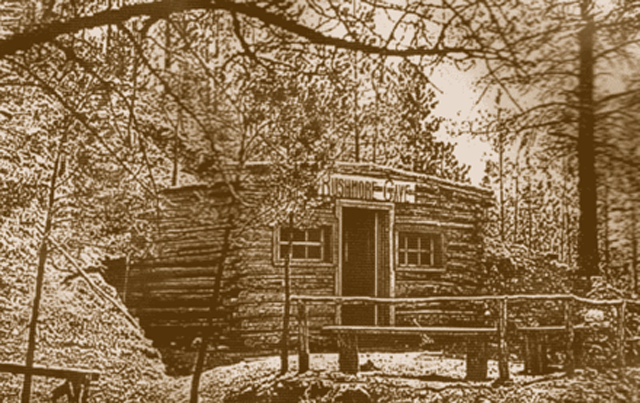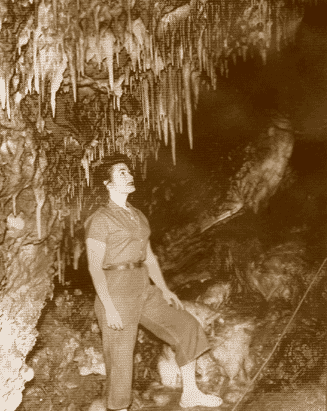
History
Rushmore Cave was discovered in 1876, shortly after the Black Hills were opened to miners and settlers. These miners were after a wealth of gold rumored to be in the area after a military expedition led by George A. Custer found the valuable mineral in French Creek in 1874. This spurred a boom in the Black Hills. Mining camps and towns sprung up all around. One such town was called Hayward.
Named after one of the miners, Charles Hayward, the town grew to a few thousand people before the mines played out and the people moved away. During the height of mining in Hayward, water was required to be brought from miles away to aid in a process called hydraulic mining. This required a series of wooden waterways, called flumes, to be built along the hills above Hayward. One flume passed along the hillside directly above what is now the original entrance to the cave. The entrance was found by accident when the flume broke and the water it was carrying disappeared into a small hole in the hillside. The miners widened the hole and entered the cave. They lowered themselves in what is now known as the Entrance Room.
The miners had little use for the cave since it contained no valuable minerals. The children of the miners, however, found the cave to be a place of wonder and explored its passages. As time passed more and more people became interested in the cave and came to see it. This convinced the family that owned the ground in which the cave was located to begin charging people to see the cave. The Ferguson family officially opened the cave in 1927 as Hermosa Crystal Cave. After closing briefly due to World War II the cave was sold in 1952 to Si and Ruth Pullen of Spencer, Iowa.
The Pullen’s changed the name to Rushmore Cave to take advantage of the growing popularity of Mount Rushmore and began the process of updating the cave and property. This included electric lights in the cave in 1956, the addition of the gift shop in 1960 and the construction of the exit tunnel in 1969. The Pullen family did great things with the business and operated the cave for 55 years. In 2008 the cave was sold and the third owners of Rushmore Cave took over. Four partners, all residents of the Black Hills, took up where the Pullen family left off. The Visitor’s Center/gift shop was updated and improved eco-friendly lighting was added to the cave route. Each year, the current owners have worked to improve the guest experience and bring innovative family friendly attractions to the Black Hills. These “top side” additions include the Soaring Eagle Zipline Ride, Gunslinger 7D Interactive Dark Ride, a lunch/snack venue called Sparky’s Snackitorium, the Rushmore Mountain Coaster and the Wingwalker Challenge Course.


How it all began

Ruth Pullen poses for an early advertising photo.
Living the American Dream, Lester “Si” and Ruth Pullen, a couple of farm kids from Iowa, arrived in the Black Hills in 1950 looking for a place to build a future for themselves and their children. As luck would have it, they landed a job as cave managers in the Northern Black Hills. Their life long adventures in tourism became a reality when they put their small savings down on a “hole in the ground” called Rushmore Cave.
Then the work began… painting signs by fireplace light, carving out a new entrance with a pick and shovel. Si awoke at dawn each morning to grade the approximate six miles of dirt road from Hayward to Keystone with Ruth following close behind in their car to remove by hand the loose rocks which the old grader had kicked up. The couple worked hard to draw visitors to their gem inside a mountain. They drove a tunnel from the surface on a decline to the heart of this limestone cave.
Starting in 1952 tours were given by kerosene lanterns 24 hours a day, as every dollar was precious! Cement was hand carried back into the far reaches of the cave in old inner tubes slung over strong arms, to build needed steps. Wires were laid and carefully camouflaged to add electric lighting in 1956. These two pioneers in the Black Hills Tourism Industry reached the American Dream and it lives today in their children and grandchildren at Beautiful Rushmore Cave. In this c. 1955 photograph,(below) Ruth Pullen looks at stalactites inside the cave.
